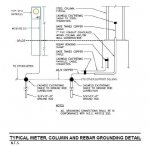innersurffer
Member
I have a school board that is requiring a 25 ohms or less ground rod resistance test with a system that is already CAD welded together with (3) 5/8" X 10' ground rods tied together with 2/0 and bonded to a ufer, structural steel, and (2) meters. This is for a small 70A service that has a shadeport structure for solar. Eventhough the inspector has said I have complied with 250.56 they still require a ground test. When we tested the 2/0 bare that came off of the ground rod we got 1 ohm or less per ground rod. When they used their independent tester (handheld clamp on tester) they came up with anywhere from 250-350 ohms when they got below the cadweld and just tested the ground rods. I understand that the clamp tester is not the best in the case of tied together system but the school boards engineers have approved their greenlee clamp on tester and are needing us to comply with the 25 ohms or less for just the ground rod. I need to know if I added a second rod next to the other ground rod and tied them together with a #6 will I get the lower ohm ratting we are looking for? Any other suggestions or comments would be appreciated.
:?
:?


